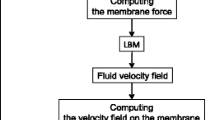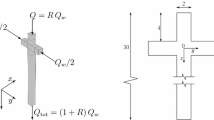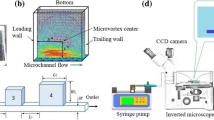Abstract
We investigate the path selection (navigation) of a single moving vesicle in a microfluidic channel network using a lattice Boltzmann-immersed boundary method (IBM). The lattice Boltzmann method is used to determine incompressible fluid flow with a regular Eulerian grid. The IBM is used to study a vesicle with a Lagrangian grid. Previous studies of microchannels suggest that the path selection of a bubble at a T-shaped junction depends on the flow rates in downstream channels. We perform simulations to observe the path selection of a vesicle with three different capillary numbers at a tertiary junction. The hypothesis that higher flow rate determines path selection is not validated by our data on low capillary number (Ca ≤ 0.025) of a vesicle in tertiary downstream channels. We use the resultant velocity hypothesis to explain the path selection of a vesicle in microfluidic systems. Our results suggest that, for a low capillary number, instead of being affected by the viscous force from a high flow rate, a vesicle in a tertiary junction tends to follow the resultant velocity hypothesis. We analyze the change in hydrodynamic resistance caused by the movement of a vesicle to support the resultant velocity hypothesis. We also study the residence time of a vesicle at a junction for different cases and analyze the relationship between the residence time and the resultant velocity. The resultant velocity (rather than the flow rate in individual channels) can be used to predict the path selection of a vesicle in low capillary number. In addition, the residence time of vesicle is decided by average velocity of each channel.







Similar content being viewed by others
References
Bagchi P, Johnson PC, Popel AS (2005) Computational fluid dynamic simulation of aggregation of deformable cells in a shear flow. J Biomech Eng 127:1070
Bhagat AA, Hou HW, Li LD, Lim CT, Han J (2011) Pinched flow coupled shear-modulated inertial microfluidics for high-throughput rare blood cell separation. Lab Chip 11:1870–1878
Chen S, Doolen GD (1998) Lattice boltzmann method for fluid flows. Ann Rev Fluid Mech 30:329–364
Choi W, Hashimoto M, Ellerbee AK, Chen X, Bishop KJ, Garstecki P, Stone HA, Whitesides GM (2011) Bubbles navigating through networks of microchannels. Lab Chip 11:3970–3978
Cupelli C, Borchardt T, Steiner T, Paust N, Zengerle R, Santer M (2013) Leukocyte enrichment based on a modified pinched flow fractionation approach. Microfluidics Nanofluidics 14:551–563
Deen NG, Annaland MS, Kuipers JAM (2009) Direct numerical simulation of complex multi-fluid flows using a combined front tracking and immersed boundary method. Chem Eng Sci 64:2186–2201
Farhat H, Lee JS, Lee JS (2011) A multi-component lattice boltzmann model with non-uniform interfacial tension module for the study of blood flow in the microvasculature. Int J Numer Methods Fluids 67:93–108
Feng Z-G, Michaelides EE (2004) The immersed boundary-lattice boltzmann method for solving fluid–particles interaction problems. J Comput Phys 195:602–628
Fox RW, McDonald AT, Pritchard PJ (2006) Introduction to fluid mechanics. Wiley, Hoboken
Fuerstman MJ, Lai A, Thurlow ME, Shevkoplyas SS, Stone HA, Whitesides GM (2007) The pressure drop along rectangular microchannels containing bubbles. Lab Chip 7:1479–1489
Gossett DR, Weaver WM, Mach AJ, Hur SC, Tse HT, Lee W, Amini H, Di Carlo D (2010) Label-free cell separation and sorting in microfluidic systems. Anal Bioanal Chem 397:3249–3267
Guido S, Tomaiuolo G (2009) Microconfined flow behavior of red blood cells in vitro. Comptes Rendus Phys 10:751–763
Guo Z, Zheng C, Shi B (2002) Discrete lattice effects on the forcing term in the lattice Boltzmann method. Phys Rev E 65:046308
Hou HW, Bhagat AA, Chong AG, Mao P, Tan KS, Han J, Lim CT (2010) Deformability based cell margination—a simple microfluidic design for malaria-infected erythrocyte separation. Lab Chip 10:2605–2613
Ismagilov RF, Rosmarin D, Kenis PJ, Chiu DT, Zhang W, Stone HA, Whitesides GM (2001) Pressure-driven laminar flow in tangential microchannels: an elastomeric microfluidic switch. Anal Chem 73:4682–4687
Jousse F, Farr R, Link D, Fuerstman M, Garstecki P (2006) Bifurcation of droplet flows within capillaries. Phys Rev E 74:036311
Kim YH, Xu X, Lee JS (2010) The effect of stent porosity and strut shape on saccular aneurysm and its numerical analysis with lattice Boltzmann method. Ann Biomed Eng 38:2274–2292
Kondaraju S, Farhat H, Lee JS (2012) Study of aggregational characteristics of emulsions on their rheological properties using the lattice Boltzmann approach. Soft Matter 8:1374
Link D, Anna S, Weitz D, Stone H (2004) Geometrically mediated breakup of drops in microfluidic devices. Phys Rev Lett 92:054503
McFaul SM, Lin BK, Ma H (2012) Cell separation based on size and deformability using microfluidic funnel ratchets. Lab Chip 12:2369–2376
Park J-S, Jung H-I (2009) Multiorifice flow fractionation: continuous size-based separation of microspheres using a series of contraction/expansion microchannels. Anal Chem 81:8280–8288
Peskin CS (2002) The immersed boundary method. Acta Numeri 11:479–517
Pozrikidis C (2001) Effect of membrane bending stiffness on the deformation of capsules in simple shear flow. J Fluid Mech 440:269–291
Prakash M, Gershenfeld N (2007) Microfluidic bubble logic. Science 315:832–835
Purwosunu Y, Sekizawa A, Farina A, Okai T, Takabayashi H, Wen P, Yura H, Kitagawa M (2006) Enrichment of NRBC in maternal blood: a more feasible method for noninvasive prenatal diagnosis. Prenat Diagn 26:545–547
Stott SL, Hsu C-H, Tsukrov DI, Yu M, Miyamoto DT, Waltman BA, Rothenberg SM, Shah AM, Smas ME, Korir GK (2010) Isolation of circulating tumor cells using a microvortex-generating herringbone-chip. Proc Natl Acad Sci 107:18392–18397
Tanaka T, Ishikawa T, Numayama-Tsuruta K, Imai Y, Ueno H, Matsuki N, Yamaguchi T (2012) Separation of cancer cells from a red blood cell suspension using inertial force. Lab Chip 12:4336–4343
Tsutsui H, Ho CM (2009) Cell separation by non-inertial force fields in microfluidic systems. Mech Res Commun 36:92–103
Vanapalli SA, Banpurkar AG, van den Ende D, Duits MH, Mugele F (2009) Hydrodynamic resistance of single confined moving drops in rectangular microchannels. Lab Chip 9:982–990
Vladisavljević GT, Kobayashi I, Nakajima M (2012) Production of uniform droplets using membrane, microchannel and microfluidic emulsification devices. Microfluidics Nanofluidics 13:151–178
Washino K, Tan HS, Salman AD, Hounslow MJ (2011) Direct numerical simulation of solid–liquid–gas three-phase flow: fluid–solid interaction. Powder Technol 206:161–169
Yamada M, Kano K, Tsuda Y, Kobayashi J, Yamato M, Seki M, Okano T (2007) Microfluidic devices for size-dependent separation of liver cells. Biomed Microdevices 9:637–645
Zhang J, Johnson PC, Popel AS (2008) Red blood cell aggregation and dissociation in shear flows simulated by lattice Boltzmann method. J Biomech 41:47–55
Acknowledgments
This work was supported by the Mid-career Researcher Program through an NRF Grant funded by the MSIP (NRF-2013R1A2A2A01015333) and the Strategy Technology Development Program (10030037) of the Ministry of Trade, Industry and Energy.
Author information
Authors and Affiliations
Corresponding author
Rights and permissions
About this article
Cite this article
Moon, J.Y., Kondaraju, S., Choi, W. et al. Lattice Boltzmann-immersed boundary approach for vesicle navigation in microfluidic channel networks. Microfluid Nanofluid 17, 1061–1070 (2014). https://doi.org/10.1007/s10404-014-1393-z
Received:
Accepted:
Published:
Issue Date:
DOI: https://doi.org/10.1007/s10404-014-1393-z




